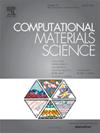第一性原理计算解释了镀铝钢对熔铝硅合金的耐腐蚀性增强
IF 3.1
3区 材料科学
Q2 MATERIALS SCIENCE, MULTIDISCIPLINARY
引用次数: 0
摘要
321钢在聚光太阳能发电系统中作为热交换器的使用寿命在很大程度上取决于其对用于储热的液化铝硅合金的防腐性能。因此,鉴于发现渗铝技术可以提高321钢的耐蚀性,基于第一性原理计算,计算了Si原子在表面渗铝层不同中间相(Fe-Al)晶面上的吸附和抑制机理,揭示了腐蚀机理。吸附能结果表明,硅原子最有利的吸附位是各晶面的空心(H)位。同时,电子定位函数和态密度表明,表面渗铝层中Al原子的存在可以减弱Fe和Si之间的电子相互作用,从而延缓Si在钢基体上的腐蚀速率。结果表明,渗铝技术能够提高321钢在液化铝硅合金中的腐蚀性能,与实验结果吻合较好。因此,本研究可为换热器用321钢的防腐提供理论指导。本文章由计算机程序翻译,如有差异,请以英文原文为准。

First-principles calculations explain the enhanced corrosion resistance of aluminized steel to molten Al-Si alloy for thermal energy storage
The service longevity of 321 steels as heat exchangers in concentrated solar power systems highly depends on their anti-corrosion performance against liquefied Al-Si alloys used for thermal energy storage. Therefore, given that aluminizing technique was found to improve the corrosion resistance 321 steels, the adsorption and inhibition mechanism of Si atoms on the crystallographic planes of different intermediate (Fe-Al) phases in surface aluminizing layer was calculated based on first-principles calculation to reveal the corrosion mechanism. The adsorption energy results showed that the most favorable adsorption sites for Si atoms are the hollow (H) site of each crystallographic plane. Meanwhile, the electron localization function and density of states indicated that the presence of Al atoms in the surface aluminizing layer could weaken the electronic interaction between Fe and Si, thereby delaying the corrosion rate of Si on the steel substrate. Consequently, aluminizing technique was capable of enhancing the corrosion properties of 321 steels in liquefied Al-Si alloy, which agree well with the experimental results. Therefore, this study could provide theoretical guidance for the anti-corrosion of the 321 steels for heat exchangers.
求助全文
通过发布文献求助,成功后即可免费获取论文全文。
去求助
来源期刊

Computational Materials Science
工程技术-材料科学:综合
CiteScore
6.50
自引率
6.10%
发文量
665
审稿时长
26 days
期刊介绍:
The goal of Computational Materials Science is to report on results that provide new or unique insights into, or significantly expand our understanding of, the properties of materials or phenomena associated with their design, synthesis, processing, characterization, and utilization. To be relevant to the journal, the results should be applied or applicable to specific material systems that are discussed within the submission.
 求助内容:
求助内容: 应助结果提醒方式:
应助结果提醒方式:


